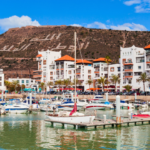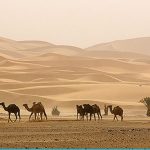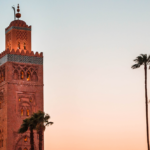By Meredith – Port Elizabeth, 25th November 2018. It has been said that “Argan oil is to Morocco what olive oil is to Italy”. For centuries Berber women have used argan oil for beautifying, medicinal and culinary properties. In recent years this secret liquid gold has gained popularity worldwide and today is widely available as an ingredient in toiletries. This super product reputedly has multiple cosmetic and health benefits, as well as a fascinating history of preparation. On a trip to Morocco, you are likely to see little bottles of argan oil and related products, like soaps, for sale in the souks. Some travelers might even take a selfie with the tree-climbing goats that love feasting on argan nuts, or indulge in a revitalizing spa experience massaged with argan and divine smelling essential oils. Most tourists will also enjoy argan oil in salads or bread dunked in argan nut paste (think delicious peanut butter). Learn more about the history and preparation of argan oil, its health properties, and importantly how to choose a high-quality product in Morocco.
History of argan oil
Table of Contents
Pure argan oil is harvested and extracted from the nut of the Argan tree (Argania Spinosa). Known by some as “the tree of life” argan trees can live 150-200 years! Argan forests occurred in north Africa and parts of Southern Europe for millions of years. Now only 860 000 hectares, possibly less, remains in Morocco and these are being quickly decimated. In an effort to ensure the future persistence of the species, it was declared a Unesco Biosphere Heritage plant over 20 years ago. Harvested from the wild conservation efforts now include growing argan trees to replenish natural forests.
Presently, argan forests only occur in a small triangular patch between three cities in southwestern Morocco. Travelers can visit argan forests and factories where the oil near Essaouira and Agadir. An average argan tree produces 140 kg of fruit yearly, which produces about 10 kg of argan kernels. Once processed about 4 l of oil can be produced from these kernels.
Argan nuts have always been harvested and pressed by Amazigh tribes women. The whole industry is run by women, which is amazing considering the patriarchal society of Morocco! Most women working in argan oil production belong to a cooperative that provides assistance and independence.
Health benefits of argan oil
The local Amazigh people of Morocco have used argan oil for centuries to soothe arthritic and rheumatic problems and lessen the appearance of scars. In recent years the argan oil craze has flooded the market with all kinds of hair and body products available. I currently use a conditioner containing argan oil, just bought at a South African store, and it leaves my hair feeling silky smooth, tangle-free, and straight. Considering this is probably such a synthetic product I can’t imagine how great the real stuff is!
Cosmetically, argan oil has great anti-aging properties (say bye-bye to age spots, fine wrinkles lines, and stretch marks!) and regular use improves skin elasticity. It can help with sore muscles and age-related aches and pains (who doesn’t enjoy a relaxing massage!). The oil can help treat dermatitis and psoriasis. For those with acne-prone skin argan oil can help reduce breakouts and is non-comedogenic, meaning it won’t block your pores. Some say that it helps soothe itchy bites as it relieves the inflammation. Rich in omegas argan oil is a great hair treatment, strengthening the hair and adding shine.
With its smooth, nutty taste culinary argan oil is perfect for cooking or dipping, or even tossed over salad, grilled vegetables, and even creamy desserts. It does not do well when heated but can be added at the end of cooking vegetables or eggs to enhance flavor. Argan nuts, oil, and honey are used to make amlou, similar to peanut butter or Nutella (delicious I promise!) that can be spread on bread or eaten as breakfast.
When ingested argan oil is effective for reducing inflammation and lowering bad cholesterol levels. Regular use of this oil is good for digestion and protects the cardiovascular system.
Preparation of argan
“It can take up to 10 hours to crack enough nuts to produce one liter of finest quality oil.”
From start to finish the whole argan oil process is very manual. Argan fruit are collected from the trees and must be husked. It is believed that traditionally the nuts were allowed to be eaten by goats, and then collected. Don’t worry, these days the process is much more hygienic! But you can take a lovely video of the goats happily munching away on the argan trees. Read more about this phenomenon in this post.
The fruit consists of three layers: a hard outer shell, a freshly middle, and a nut that can have 1-3 kernels. The flesh of the seed is often used as animal feed and the outer husk for firewood. The fruit are husked by cracking the pods between two rocks. The smooth caramel-colored pits are then ground into a paste. The paste is kneaded or pressed with a little bit of water to extract the oil.
Cosmetic argan oil is cold-pressed whereas culinary argan oil is roasted. Cold pressing retains the oil’s high Vitamin E properties. They can be distinguished by the smell – culinary argan oil has a distinct nutty flavor whereas cosmetic argan oil has no noticeable smell.
How to choose good quality argan oil
Argan oil is for sale in all spice shops and traditional chemists throughout the medinas of Morocco. There is no set price for argan oil and thus price as well as quality varies greatly. I have read that a 150ml bottle of quality argan oil will cost in the region of 200 Dirhams (roughly US $20). Unfortunately, I didn’t take notes while in Morocco. Maybe some of our readers know and can post a comment? Please?
There are a few regulations to certify argan oil, but there are a few ones to determine how to buy the best quality product. Pure organic Argan oil should only have one and only ingredient: Argania Spinosa. Real argan oil is clear (sometimes slightly murky) dull yellow in color. Brighter yellow indicates the argan oil has been diluted with other oils. Argan oil should be light when applied to the skin and absorb slowly over time it will. It should not wash off too easily either. Argan oil should be sold in dark glass bottles and stored out of direct sunlight.
Proper manufacturers in Morocco will be EcoCertified (EcoCert is one of the world’s most respected international certifications of organic products). This provides a guarantee that the argan oil is top quality and environmentally friendly. Look for batch numbers and expiration dates-argan oil stored correctly has a shelf life of 2 years.
Don’t forget to haggle to get good prices on your argan oil purchases and reap the benefits of this liquid gold! Stay tuned for future posts on what to expect inside a traditional Berber pharmacy. Now run along and start pouring argan oil over all your problems!
Join countless satisfied travelers who have experienced Morocco with us. We customize every detail to make your Moroccan adventure uniquely yours. Explore the Magic of Morocco with us!





































































































































































































































































